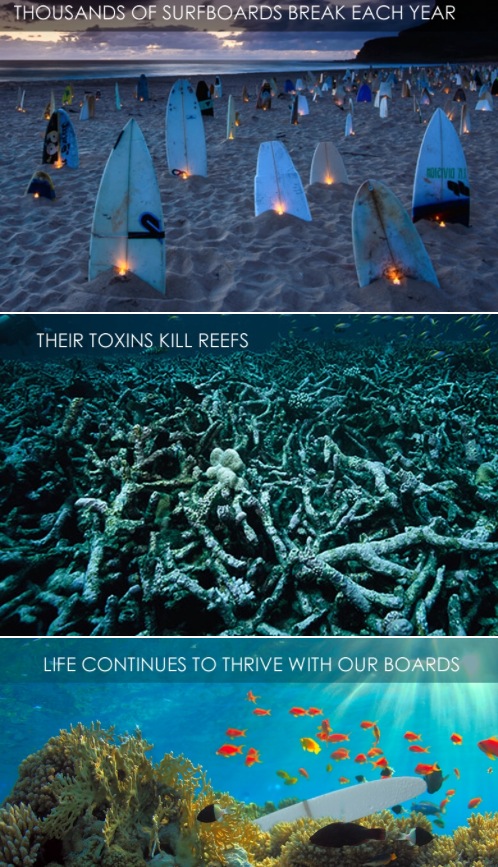by Amanda Crater. See her full article at MainandPCH.
It is no secret that surfers love the ocean and want to protect the environment, but who knew that surfing can be toxic? In  a sport that is constantly evolving, in a town at the very heart of the surfing industry where pros and brands are born, Larry Bertlemann — Hawaiian surfing legend who shook up a generation of surfers with his unique style and approach to the industry in the 1970s — is once again carving his mark onto future generations of surfers through his company, “Be Better Boards” by Bertlemann.
a sport that is constantly evolving, in a town at the very heart of the surfing industry where pros and brands are born, Larry Bertlemann — Hawaiian surfing legend who shook up a generation of surfers with his unique style and approach to the industry in the 1970s — is once again carving his mark onto future generations of surfers through his company, “Be Better Boards” by Bertlemann.
Larry “Rubberman” Bertlemann was on the scene of this year’s US Open of Surfing in Huntington Beach, getting inducted into the surfing Walk of Fame and drawing attention to an issue that is near and dear to the heart of surfers everywhere: the health of the ocean and the people who love to be in it.
“There are only two types of people in this whole world, leaders and followers, and I don’t follow nobody,” Bertlemann told MainandPCH at his Be Better Boards induction party July 31. It’s this passion and game-changing attitude that makes Bertlemann the perfect representative for a company started by a bunch of local surfers with a groundbreaking technology to keep the ocean and environment clean.
“Be Better Boards by Bertlemann” uses the revolutionary “be better foam” product developed by Lake Forest-based company AirTech Foam to produce eco-friendly surfboard blanks.
“I have a little product, which is really really good, it’s called a green blank,” Bertlemann said, “which means the board I make and will make will not kill our planet.”
Surfing is not traditionally associated with killing the planet, but surfboards containing toxic foams take a surprising toll on both the people who shape them and the reefs where they break and remain.
“You can imagine how many boards break a day in Hawaii, those boards are toxic,” said AirTech Foam Chairman Blake T. Ward. “If you look underneath the Pipeline and other places where a lot of boards break and they get stuck in the reef you’ll see that the reef is dead, and we did that in our lifetime.”
Ward also explained that people shaping boards have died from exposure to the “horrific airborne particles” used in the manufacturing process. He said Californian surfboard blank manufacturer Clark Foam, which dominated the market from 1961-2005, “closed for a reason.”
Now AirTech Foam is stepping up to supply the surfing industry with a superior product they have developed and tested and created a variety of applications for, including buoys, booms, home care and cleansing products. In response to the BP oil spill in the Gulf of Mexico in 2010, AirTech management joined with one of the top chemists in the world to formulate a new, non-toxic foam product made from renewable resources.
LOCAL COMPANY BRINGING SHAPING BACK TO ITS ROOTS
“We’re a bunch of local guys that have a love of the ocean and grew up with all the surfers,” Ward said of AirTech Foam, the parent company of Be Better Boards by Bertlemann. “We have a love of the ocean, but we don’t realize that we’re not very good stewards of the ocean if we’re paddling around on a board that will literally pollute the ocean and put [volatile organic compounds] in the environment, kill the reefs, kill the fish. The fish eventually eat the foam, we eat the fish, what do you think goes to us?”
Clark Foam used toluene diisocyanate [TDI] in the manufacturing process, one of the last California manufacturers to do so, and had been faced with threats of being shut by the United States Environmental Protection Agency (EPA) before its abrupt closure in 2005 sent shockwaves through the industry and left surfboard shapers scrambling for new suppliers.
“TDI foam is bad, it’s horrific,” Ward said. “Where we grew up was the beginning of surfing, California and Hawaii, we did the products here, we started off here.” EPA regulations and the loss of market share by local companies has caused the bulk of manufacturing blanks to be done overseas, Ward explained.
“We want to bring that back to California, take it back from the places where they don’t surf,” he said. Be Better Boards has been working with local shapers like Dave Moore of DMZ in Huntington Beach to get their product road tested by the people at the forefront of surfing.
“We’ve got the best of the best, we’ve got Larry Bertlemann, who’s a legend, we’ve got his friends and associates….
BRINGING BERTLEMANN ON BOARD
Always one to influence the sport of surfing with his unabashed style and full embrace of corporate sponsors (see SIDE BAR), Bertlemann in the past five years has become a passionate promoter of Be Better Boards and was brought on to be the main voice and face the company as VP of Marketing and Sales.
SIDEBAR ON LB FROM SURFER MAG
Bertlemann’s obsession with image and commercialism, meanwhile, put him on the wrong side of surfing purists. Always fashion conscious, instantly recognizable by his neatly tended Afro hairstyle, Bertlemann frequently surfed and skateboarded in color-coordinated outfits, and at one point took to the waves at Pipeline wearing a customized blue-and-red bell-bottom wetsuit. A pioneer in surf world corporate sponsorship, Bertlemann by the late ’70s was plastering his boards with oversize stickers from Pepsi, United Airlines, and Toyota, and even adopted the Pepsi swirl emblem for his board’s design motif.
“If you’re not riding my blanks or my boards, then you’re killing it [the planet],” the ever bold Bertlemann told us. “They won’t let that happen because the Hawaiian people love our ocean and our island, we always take care of it.”




One response to “Saving The Planet, One Green Surfboard At A Time”